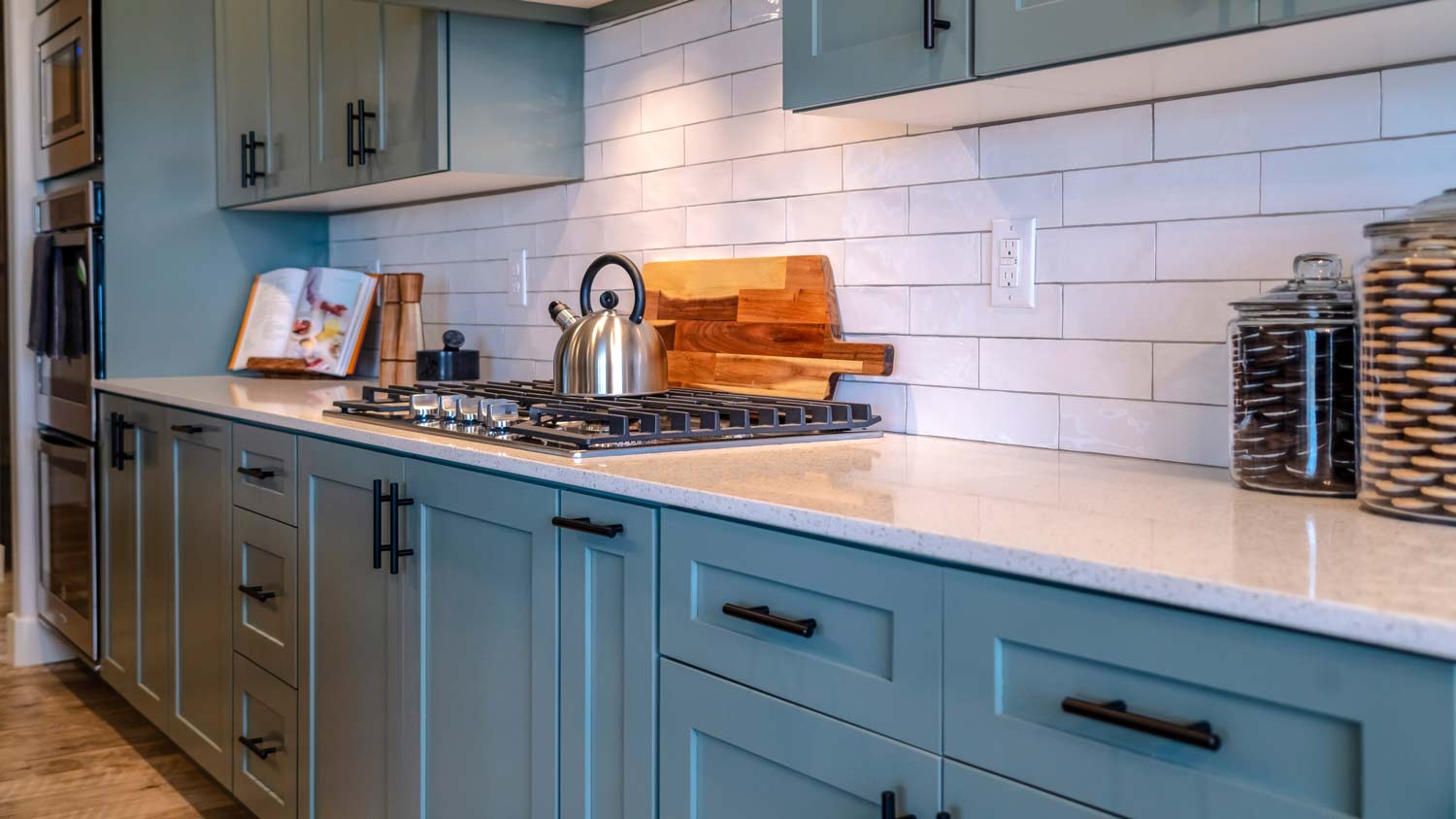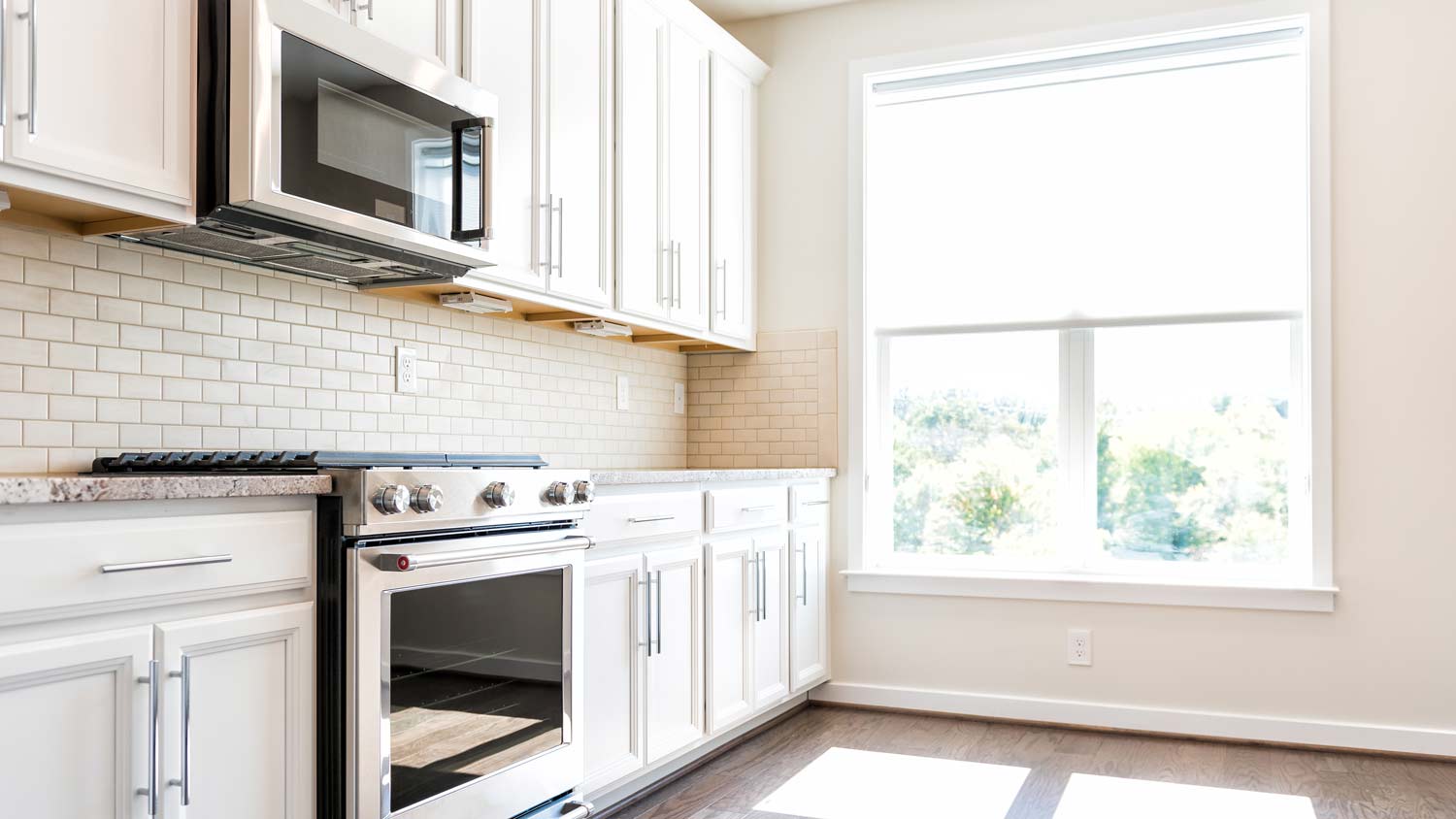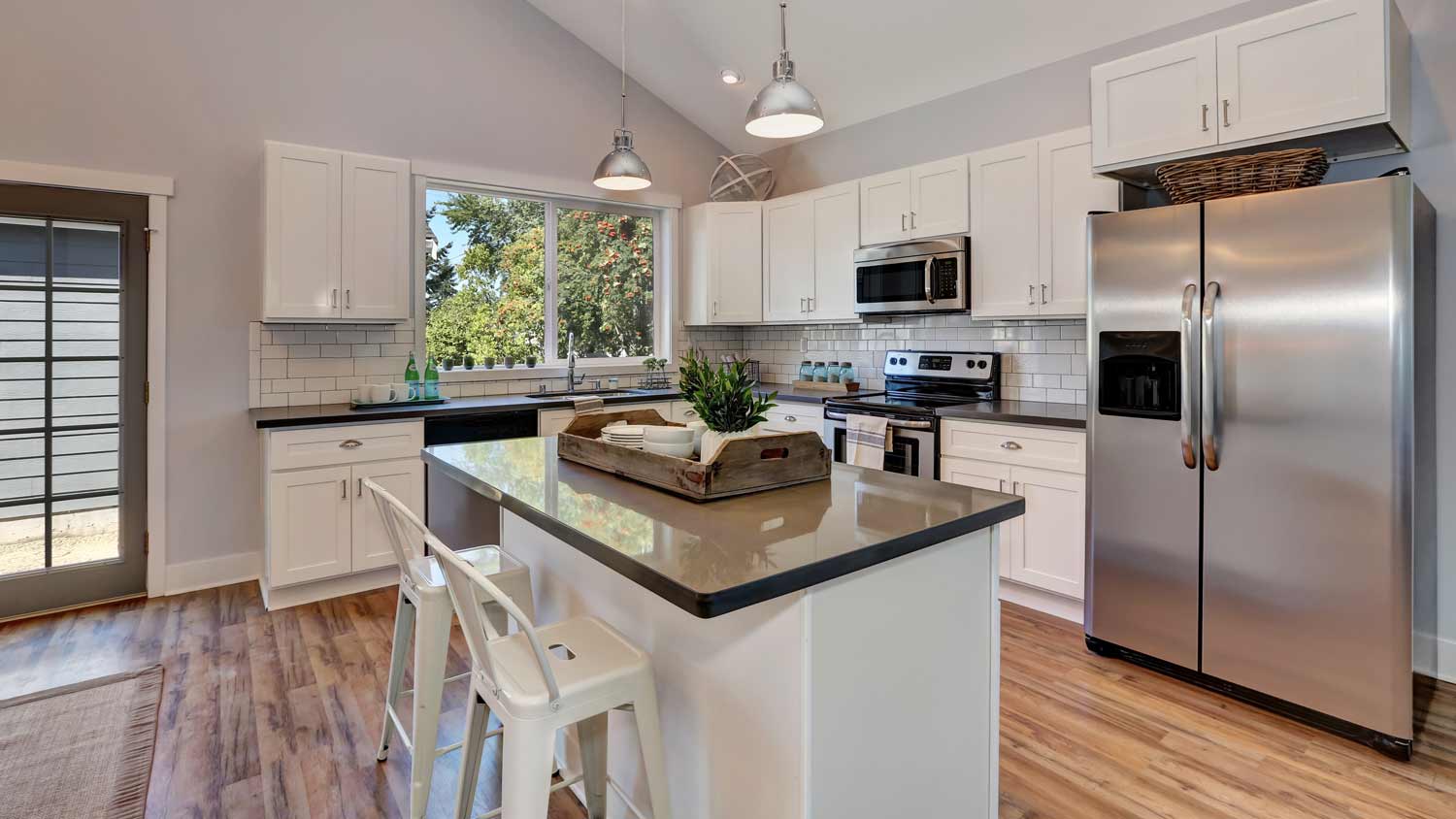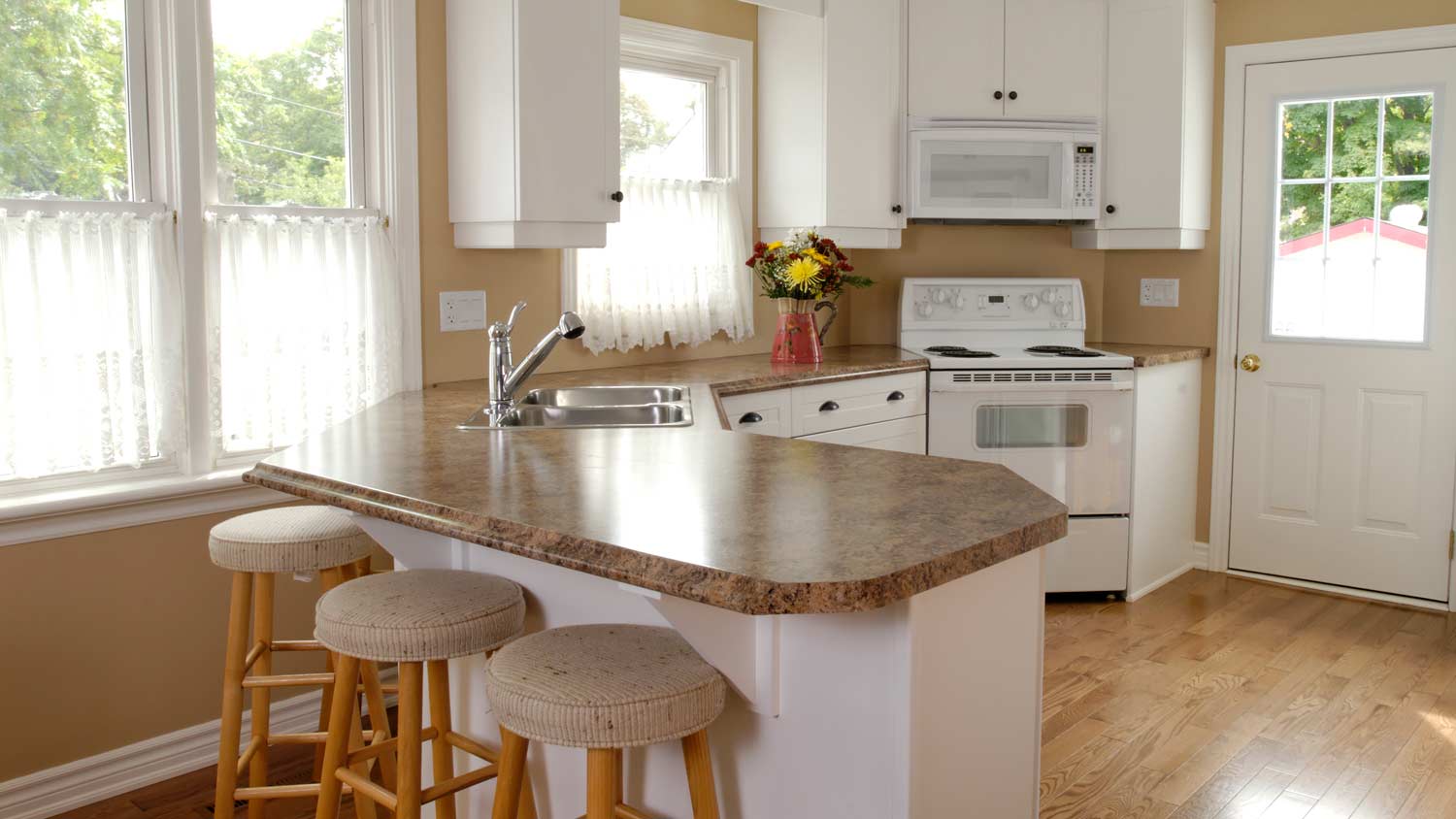What Is the Best Paint Sheen for Kitchens?
Let the hardest-working room of your house shine


Paint sheens, or finishes, are defined by how much gloss is added to the mix. The gloss, which is made from resin, adds sheen while also making the paint easier to clean and more resistant to moisture. The additional light reflected off the walls, however, can highlight imperfections in the surface.
From shiniest to flattest, paint finishes go from high-gloss, semi-gloss, and satin, to eggshell, matte, and flat. When choosing the best paint sheen for kitchens, the protective resin that adds shine to the paint is necessary to protect walls from moisture, grease, heat, food stains, and more.
While you might love the elegant, smooth look of matte and flat paint, practicality is essential in a kitchen, so you should ideally choose high-gloss or semi-gloss for the walls and cabinets. Still, if you dislike shine, satin is usually acceptable for walls and ceilings, and eggshell can be used on ceilings. When you have a backsplash for added protection from splatters and splashes, or if you do not cook much, you can choose eggshell, but be prepared to repaint if it gets damaged by cleaning or moisture.
| Paint Finish | Average Gloss (Resin) Content | Where to Use in Kitchens |
|---|---|---|
| High-Gloss | 70% or more | Cabinets |
| Semi-Gloss | 41%–70% | Anywhere |
| Satin | 26%–40% | Ceilings and walls |
| Eggshell | 11%–25% | Ceilings and walls with backsplashes |
| Matte | 5%–10% | Nowhere |
| Flat | Up to 4% | Nowhere |
1. High-Gloss Paint

Defining high-gloss paint can be confusing, as some companies have a “gloss paint” with a sheen level between 70% to 84% and an even shinier high-gloss paint with upwards of 85% gloss. Other companies call anything with more than 70% gloss “high-gloss.” Regardless of the name, the more glossy resin is added to paint, the more protection it offers against moisture, stains, and scuffs—but it will also highlight more imperfections in the paint job and the underlying surface.
Beyond that, applying this paint is difficult because any brush marks, paint drips, or bubbles left in the paint will look highly obvious when light reflects off them. Because it can be so hard to apply high-gloss paint without leaving behind highly noticeable imperfections, consider hiring a local interior painter for these jobs.
| Pros | Cons |
|---|---|
| High moisture resistance makes it easy to clean. | Difficult to apply properly |
| The most durable of all paints | Highlights imperfections in the surface or paint job |
| Can help highlight details in cabinetry | Many find sheen unattractive. |
Best for: Kitchen cabinets
2. Semi-Gloss Paint

Semi-gloss paints have a gloss content of anywhere between 40% and 70%. It is much easier to apply without leaving behind brush strokes, drip marks, or bubbles. This sheen can still be easily washed, and it holds up well against stains, grease, water, and other common kitchen mishaps. While it is best to use high-gloss paint only on cabinets because you want to minimize the chances of seeing scratches, dents, and paint mishaps all over your walls, semi-gloss looks and performs well on ceilings, cabinets, and walls. For these same reasons, it is also considered the best paint for garage walls and ceilings.
While some people dislike the luster of semi-gloss paint, it looks more appealing to the average person than shiny high-gloss paint. Beyond that, it can certainly speed up the painting process if you choose a single hue of semi-gloss paint that can be applied to all of your walls, cabinets, ceilings, and baseboards.
| Pros | Cons |
|---|---|
| Easy to clean | Some people prefer paints with less luster. |
| Durable and scuff resistant | Highlights imperfections in paint and wall texture |
| Easier to apply than high-gloss |
Best for: Kitchen walls, baseboards, cabinets, ceilings—anywhere in the kitchen
3. Satin Paint

If you do not like the look of shiny paint, then satin, sometimes called low-sheen, is a good option. It offers a nice balance between matte paint’s appearance and the protection offered by semi-gloss paint. Though satin reflects some light, it does not look shiny and, instead, has a more velvety luster like its namesake. Similarly, the gloss in satin paint makes it easy to wipe clean and resistant to water damage. Unfortunately, it takes a long time to dry.
While you can use satin on walls or ceilings, it is best to avoid using on high-touch surfaces like cabinets that are more prone to grimy fingerprints, scuffs, and scratches. Similarly, if you use your kitchen a lot, do not have a backsplash, have messy kids, or hate repainting, you may find the protection of semi-gloss preferable for your walls.
| Pros | Cons |
|---|---|
| Rich, velvety appearance | Does not offer the same level of protection as semi-gloss |
| Easy to wipe clean | Takes a while to dry |
| Water resistant | Not durable enough for kitchen cabinets |
Best for: Kitchen walls or ceilings
4. Eggshell Paint

For an option with even less shine, look to eggshell. Like its namesake, this paint still has a tiny bit of shine, which some people appreciate aesthetically, especially if they have older walls that have been repaired multiple times over the years. The lowered reflectivity, however, translates to less moisture resistance, scuff protection, and overall durability.
Eggshell may be a good option if you do not mind repainting your kitchen every few years and want something more forgiving of imperfections. Even so, because it is less durable than the other options, you should only apply this on kitchen ceilings or walls protected by backsplashes. If you cook frequently, it is better to use a more durable option.
| Pros | Cons |
|---|---|
| Attractive, lower-shine appearance | Less durable than other options |
| Offers some level of moisture resistance | Can be damaged by repeated cleaning |
| Hides imperfections in the paint job and wall | More prone to moisture damage |
Best for: Kitchen ceilings or walls without backsplashes in lesser-used kitchens
Why You Should Avoid Using Matte and Flat Paints in the Kitchen
Resin—the water resistant gloss used to increase the sheen in paint—helps bond pigment to the wall. The less resin in paint, the more likely it will rub or chip off when cleaned or exposed to moisture. This can be a serious concern when dealing with a room frequently exposed to steam, food spills, water splashes, grease splatters, and more. While matte and flat paints may look attractive given their light-absorbing, imperfection-hiding nature, they are best reserved for rooms with less traffic and moisture.
Which Finish is Most Popular for Kitchens?
Semi-gloss paint is the most widely used finish for kitchens due to how well it stands up to grease, water, stains, steam, and other side effects of kitchen activity. The semi-reflective surface helps brighten up even a small kitchen, and unlike satin paint, semi-gloss can stand up to frequent cleaning and high traffic, making it an easy choice for this busy room.
Best Paint Finish for Cabinets
Kitchen cabinets take the brunt of kitchen activity, from being opened and closed multiple times a day to catching water and grease splatters, so these surfaces need paint that’ll stand up to heavy use. High-gloss paint is not only the most durable finish, but it’s also easy to clean, so no matter how much abuse your cabinets take, you’ll be able to keep them looking great.
Frequently Asked Questions
While often used interchangeably, flat and matte paints are not the same. Flat paint has no gloss and is completely shine-free, while matte has up to 10% resin, giving it a slightly velvety appearance. That small amount of gloss in matte paint gives it a more elegant, modern appearance than flat paint, though flat paint is ideal for hiding imperfections in even the most dented, scratched, and repeatedly repaired surfaces.
Yes, you can limewash kitchen walls. In fact, if you hate the appearance of shiny paint and love the look of rustic, European-style kitchens, you might prefer using limewash over paint. Limewash is durable because it penetrates brick and plaster, eliminating the need for the protection of glossy resin. As a bonus, the natural breathability of limewash makes it resistant to the growth of mold and fungi, which is ideal for a moisture-prone area like the kitchen.





- Satin vs. Semi-Gloss Paint Finish: What’s the Difference?
- What’s the Difference Between Satin and Semi-Gloss Paint?
- Best Paint Finish For Bathroom: A Complete Guide
- The Ultimate Guide to the 5 Types of Paint Finishes
- Eggshell Paint vs. Semi-Gloss: What’s the Difference?
- The Best Paint for Interior Doors
- Does Shower Steam Affect Paint?
- The 5 Best Paint Sheens for Bathrooms
- The 7 Best Paint Sheens for Your Bedroom
- Best Paint For Cabinets—Oil, Enamel, or Hybrid?










